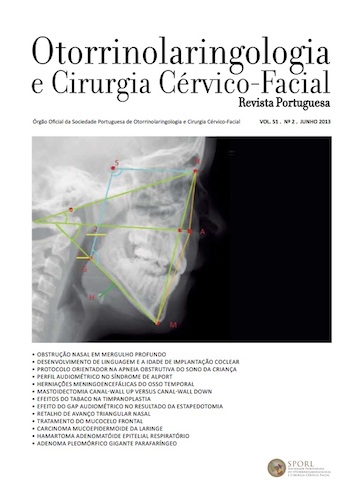Language development in children with cochlear implant and the influence of age at implantation
DOI:
https://doi.org/10.34631/sporl.16Keywords:
Cochlear Implant, Hearing Impairment, Language DevelopmentAbstract
Introduction: Cochlear implantation allows auditory stimulation in individuals with bilateral profound hearing loss with limited benefits from conventional hearing aids. This device facilitates language development in children with profound sensorineural congenital hearing loss. The language development of children who use cochlear implants has differences when compared with that of normal-hearing children. This study investigated the linguistic performance of children who use cochlear implant over time and the influence of age at implantation on the results.
Materials and methods: Study on the spoken language development in children with profound sensorineural congenital hearing loss implanted between 19 to 60 months of age in Centro Hospitalar de Coimbra. The evaluation instrument was a Portuguese Language Development Test (Teste de Avaliação da Linguagem na Criança). The participants were divided into 4 groups, based on age at implantation: before 25 months, from 25 to 36 months, from 37 to 48 months and after 48 months of age.
Results: A comparison was made between the results of the four implanted children groups, as well as with normative data available for the test used. The implanted group that showed the best final results and the evolution curve most similar to that of the normative data was the group implanted before 25 months of age. No statistically significant differences were found between the studied groups.
Conclusion: The collected data indicates a positive effect of early implantation on language development. The obtained results are in agreement with the literature. New studies should include more individuals and the evaluation of other aspects of child development.
Downloads
References
Niparko JK, Tobey EA, Thal DJ, Eisenberg LS, et al. Spoken Language Development in Children Following Cochlear Implantation. J Am Med Assoc. 2010;303(15).
Sininger YS, Grimes A, Christensen E. Auditory Development in Early Amplified Children: Factors Influencing Auditory-Based Communication Outcomes in Children with Hearing Loss. Ear Hear. 2010;31(2):166-185.
Connor CM, Craig HK, Raudenbush SW, Heavner K, et al. The Age at Which Young Deaf Children Receive Cochlear Implants and Their Vocabulary and Speech-Production Growth: Is There an Added Value for Early Implantation? Ear Hear. 2006;27(6):628-644.
Monfort M, Sánchez AJ. Rehabilitación e intervención pedagógica. In: M. J. Manrique Rodríguez AHI (Ed.) Implantes Cocleares. Barcelona: Masson; 2002.
Kim L-S, Jeong S-W, Lee Y-M, Kim J-S. Cochlear implantation in children. Auris Nasus Larynx. 2010;37(1):6-17.
Vlastarakos PV, Proikas K, Papacharalampous G, Exadaktylou I, et al. Cochlear implantation under the first year of age - The outcomes. A critical systematic review and meta-analysis. Int J Pediatr Otorhinolaryngol. 2010;74(2):119-126.
Holt RF, Svirsky MA. An Exploratory Look at Pediatric Cochlear Implantation: Is Earliest Always Best? Ear Hear. 2008;29(4):492-511.
Sharma A, Dorman MF, Kral A. The influence of a sensitive period on central auditory development in children with unilateral and bilateral cochlear implants. Hear Res. 2005;203:134-143.
Hayes H, Geers AE, Treiman R, Moog JS. Receptive Vocabulary Development in Deaf Children with Cochlear Implants: Achievement in an Intensive Auditory-Oral Educational Setting. Ear Hear. 2009;30(1):128-135.
Fortunato CAdU, Bevilacqua MC, Costa MdPRd. Análise comparativa da linguagem oral de crianças ouvintes e surdas usuárias de implante coclear. Revista CEFAC. 2009;11(4).
Dettman SJ, Pinder D, Briggs RJS, Dowell RC, et al. Communication Development in Children Who Receive the Cochlear Implant Younger than 12 Months: Risks versus Benefits. Ear Hear. 2007;28:11S-18S.
Stuchi RF, Nascimento LTd, Bevilacqua MC, Neto RVdB. Linguagem oral de crianças com cinco anos de uso do implante coclear. Pró-Fono Revista de Atualização Científica. 2007;19(2).
Flipsen P, Colvard LG. Intelligibility of conversational speech produced by children with cochlear implants. J Communicat Dis. 2006;39:93-108.
Nicholas JG, Geers AE. Effects of Early Auditory Experience on the Spoken Language of Deaf Children at 3 Years of Age. Ear Hear. 2006;27(3):286-298.
Martins JH, Alves M, Andrade S, Januário J, et al. (Re)habilitação auditiva através de Implante Coclear: Avaliação audiológica, da linguagem, fala e voz (estudo preliminar). Rev Port ORL. 2008;46(4).
Giusti E, Befi-Lopes DM. Tradução e adaptação transcultural de instrumentos estrangeiros para o Português Brasileiro. Pró-Fono Revista de Atualização Científica. 2008;20(3).
Kay ES, Tavares MD. Teste de Avaliação da Linguagem na Criança. Lisboa: Oficina Didáctica; 2006.
Tsiakpini L, Weichbold V, Kühn-Inacker H, Coninx F, et al. Questionario Auditivo Littlears - manual: Med’el; 2003.






